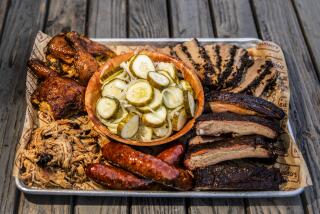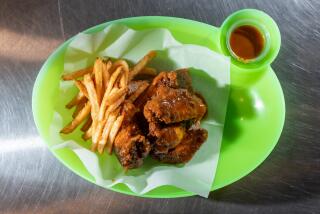Haute Links Conquer America
- Share via
NEW ORLEANS — Not a decade ago, Louisiana sausages were regional treats: Cajuns snacked on hot boudin , cooks along the river seasoned their gumbos with andouille from a few local butchers, and New Orleanians sandwiched their hot, smoked and Italian sausages in French bread.
Today, andouille is a household word in California and might just as easily be heard in Kansas or Washington. Boudin too has reached the masses, and sausages generally have gotten hotter and more highly seasoned nationwide as part of the fallout of the Cajun craze of the ‘80s.
“There are all sorts of variety today,” says John A. Manda, president and chief executive officer of Manda Fine Meats in Baton Rouge, La. For years, smoked pork was the basic ingredient of sausage made in Louisiana. “I don’t remember anything else until about five years ago,” Manda says.
Now Manda distributes a variety of sausages in 26 states as the taste for the spicy food items has spread throughout the country. “Ours are more seasoned than sausages from other parts of the country, and people love flavor; I don’t care what they’re buying,” he says.
Louisianians flavor their sausages with many seasonings--green onion, cheese, barbecue sauce. And the changes haven’t stopped there. Most sausages are getting leaner, some with only 10% fat; many have a fat content of 15% to 25% (new labels cite percentages). And many are made partly of chicken or turkey in addition to pork and beef. Manda says that sausage sales are booming, partly perhaps because they’re now leaner.
*
And Louisiana chefs share credit with Cajun/Creole cooking shows on television for making sausages best-sellers. “John Folse, Justin Wilson, Paul Prudhomme have made (Louisiana sausages) popular,” Manda says.
Vaughn Schmitt, a member of the family that owns Creole Country, a Louisiana sausage factory, says that andouille and tasso , a smoked seasoning meat, are popular in pastas and other upscale dishes in restaurants everywhere.
Schmitt cites health concerns as a factor in his business. “I’m selling more turkey than I used to,” he says. “People come in here with heart problems and they can order 10 pounds of turkey sausage with no salt.” Schmitt, who makes heart-healthy sausages for a local hospital, says allspice and other seasonings are used in place of salt. “It still tastes good,” he adds.
In the world of sausage-making, Peter Giovenco described himself as a sort of subcontractor. The St. Rose, La., butcher takes in wild game from hunters and makes sausage from it--duck, rabbit, seafood, turtle, alligator--even rattlesnake sausage. “I do what most people don’t want to do,” he says. “If somebody wants wine and cheese or nuts or raisins (in the sausage), I’m the guy that’s going to do it.”
Giovenco combines pork and the wild game of choice with Louisiana seasonings that he blends himself. The seasonings, he says, make the difference. In addition to pepper and spices, Giovenco usually adds onions, green onions and parsley to sausage. Some Italian sausage calls for anise or fennel seeds, depending on what the customer wants.
*
A Louisiana butcher for 29 years, Giovenco says sausage tastes have long varied from community to community. “Italian sausage varied from Chalmette to Baton Rouge,” he says. “Everybody had an idea about how to make it. Some put parsley and green onion in it, some put anise, and others, fennel seeds.
“ Boudin was made for years primarily by country people. It’s the same thing as Cajun rice--just cooked rice, pork and liver. They slaughtered a hog and used the casings to stuff the sausage. They didn’t throw away anything.”
Even the snouts were used back then, and rice was used to pad the meat scraps and liver that produced boudin , he says.
Andouille, he recalls, was “a souped-up smoked sausage with about a 5% to 95% ratio of fat to lean.” A highly seasoned product, it was made in the country, especially in the LaPlace, La., area. Dubbed the Andouille Capital of the World, LaPlace still is the home of some of the best andouille, although the sausage is now made throughout the state and in other states as well.
“In Louisiana we don’t have rules when it comes to food,” he says.
What’s next?
Maybe nutria sausage, Giovenco says.
*
For a mini-boucherie at home, here’s how to make your own sausage. Add your seasonings to meat, then take a small portion and cook in skillet until done, then taste and adjust seasonings.
FRESH OR SMOKED PORK SAUSAGE
Pure pork, such as boneless Boston butt
Salt
Cayenne pepper
White pepper
Black peppers
Casings
Grind or have butcher grind pork to medium grind.
To pure pork, add 6 parts salt, 3 parts cayenne pepper, 1 part white pepper and 2 parts black pepper. Add enough water to make loose stuffing. Stuff into casings. Tie into links, if desired, forming ropes.
Note : Casings are available from butchers. And some butchers will grind, season, mix and stuff your sausage into casings.
COOKED FRESH PORK SAUSAGE WITH GRAVY
Fresh Pork Sausage
Water
Onions
Green peppers
Celery
Flour
Finely chopped green onions
Parsley
Keep Fresh Pork Sausage in refrigerator or freezer. When ready to cook, place in heavy skillet and cover with water. Cook on medium-high heat until water disappears, about 45 minutes. Let sausage brown, turn and brown on all sides.
Remove sausage from skillet and make gravy by deglazing skillet with water, onions, green peppers and celery to taste. Return sausage to skillet, making sure water is about halfway up sausage links. Cover and cook on low heat about 1 hour.
To thicken gravy, add spoonful of dark roux (cooked mixture of flour and fat) at end. Sprinkle with finely chopped green onions and parsley to taste. Can be served over yellow grits for breakfast or fresh-smothered potatoes for lunch.
SMOKED PORK SAUSAGE
Fresh Pork Sausage
Place Fresh Pork Sausage over indirect heat in covered charcoal grill. Coals should be on 1 side of grill and sausage on other. Add green twigs or branches, such as pecan or oak, to coals and smoke 4 to 6 hours. Make sure coals are completely covered with branches and logs that are sized to suit grill.
Close off air vents to grill with maximum smoke and to keep branches from catching fire. If branches are freshly cut, they do not have to be dampened. Keep grill covered throughout smoking time. It is best not to open grill. Sausage is done when internal temperature reaches 155 degrees.
BOUDIN
Cooked rice
Pork, such as boneless Boston butt
Pork liver
Salt
Red pepper
Black pepper
White pepper
Chopped green onions
Chopped parsley
Casings, available from butchers
Use 40% rice, 40% pork and 20% liver. In separate pans of water, boil pork whole or in chunks and pork liver until done. Drain and save some of pork stock.
Grind pork and liver finely. Mix meat and liver with cooked rice. Add little pork stock for moisture. In bowl mix to taste salt and red, black and white peppers, green onions and parsley. Stuff into casings.
Keep refrigerated or frozen until ready to eat. Steam in pan with water until done, or grill, turning frequently. Do not overcook or casings will burst.
If steaming, cook only 2 minutes. On grill, turn every 30 seconds and cook several minutes.
More to Read
Sign up for The Wild
We’ll help you find the best places to hike, bike and run, as well as the perfect silent spots for meditation and yoga.
You may occasionally receive promotional content from the Los Angeles Times.






